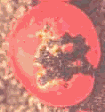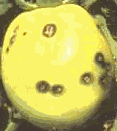
|

|
| Bacterial speck | Bacterial spot |
Fungicides /Incidence of Diseases
Bacterial speck and bacterial spot

|

|
| Bacterial speck | Bacterial spot |
|
Disease |
Symptoms |
Fungicide |
Method of application/ Control Measures |
|
Name:- Bacterial Speck (Pseudomonas syringae pv. Tomato) Source: - Infected seed, transplants, tomato crop residue, several weed hosts. Name:- Bacterial spot (Xanthomonas campestris) Source:- Infected seed, transplants, tomato crop residue, several weed hosts. |
Favoring Conditions Both: Splashing rain sprinklers. Leaf: -. small black specks, some with yellow halos. Specks coalesce, black ragged leaf margins. Stem: - superficial black raised specks with yellowish ring or halo. Later scabby, with darker halos. Hard to peel Root and fruit: - causes round water soaked spots, which gradually become yellowish brown and finally blackish brown with sunken ashy centre and pale yellowish green halo. Later, the spots become irregular to circular, measuring 1.0mm in diameter.
Overall symptoms are similar to bacterial speck. Spot: favored by warmer conditions. Leaf: -. Severe spotting may cause distortion and death of leaflets. Stem: - on the stem and petiole the lesions are large, black and canker like. Root and fruit: - lesions on unripe green fruits become corky and resemble small scab with irregular margins. |
Mercuric chloride (1:1000 )
Agrimycin-100 (100 ppm)
Same as bacterial speck.
|
Seed Treatment at 50 degree C for 25 min
Spraying at 10 days interval Resistant varieties. Hot water treatment of seeds at 50 degree C for 25 minutes is effective in killing the bacterium.
Same as bacterial speck.
|